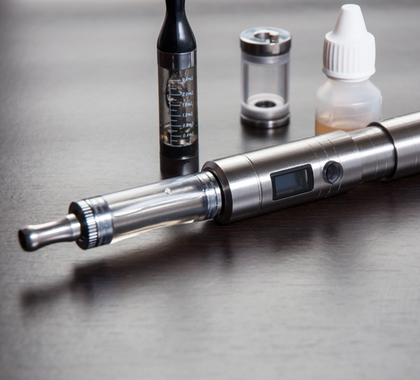On October 3, the Centers for Disease Control and Prevention (CDC) provided an update to its investigation into recent vaping-related hospitalizations. According to CDC, as of October 1, there have been “1,080 confirmed … lung injury cases associated with e-cigarette product use, or vaping.” CDC also noted 78 percent of patients “reported using [tetrahydrocannabinol] THC-containing products, with or without nicotine-containing products.” Moreover, 37 percent of patients reported “exclusive use of THC-containing products.”
These findings are similar to a CDC Morbidity and Mortality Weekly Report (MMWR) published as Early Release on September 24, 2019. Of the then-reported 805 cases, CDC presented information on 514 patients, about 64 percent of the reported cases. Of the 514 patients self-reporting, 395, 77 percent, “reported using THC-containing products.” Further, 210 patients, 41 percent, “reporting using both THC-containing and nicotine-containing products.”
CDC’s findings are similar to reports from several state health departments. In August 2019, the Wisconsin Department of Health Services reported 89 percent of patients who had been interviewed “reported using e-cigarettes or other vaping devices to inhale THC products.” In September, the Minnesota Department of Health concluded a vaping-related death “was associated with vaping illicit THC products.” Further, all of the Minnesota patients who were interviewed “reported vaping illicit THC products.” Unfortunately, several more deaths have been attributed to vaping THC-laced products. The Oregon Health Authority (OHA) reported two-vaping related deaths. In both cases, OHA reports the victims had consumed THC products before passing away, according to statements issued on September 3 and September 26.
Even states in which no vaping-related deaths have occurred have had patients report use of vaping devices containing THC. The Connecticut Department of Public Health “interviewed 9 of the 13 patients with vaping-related injury.” All nine patients reported using THC products. According to the Texas Department of State Health Services, 87 percent of interviewed patients “reported vaping products containing [THC].” The Utah Department of Health (UDOH) reported “71 cases of vaping-related lung injury.” UDOH gathered data on 36 cases and found 34 patients, or 94 percent, self-reported use of “any THC cartridges.” In Utah, 13 patients, or 36 percent, reported exclusive use of THC vaping devices.
Further, the Utah Public Health Laboratory tested 39 vaping devices: 51 percent contained e-liquid nicotine and 49 percent contained THC. Among the nicotine-containing liquids, 100 percent “contained nicotine and none have shown unexpected compounds.” On the other hand, 90 percent “of the THC cartridges contained Vitamin E acetate.” There is little research on the effects of inhaling Vitamin E acetate, but it is a lipid, which is “highly toxic and have been associated with lung injury for years.” Regulated e-cigarettes and vaping devices do not contain any oils.
Due to recent media fear mongering, governors in several states have unilaterally banned the sales of flavored e-cigarettes, and one governor has even banned sales of all e-cigarettes. Below is a rundown of recent bans:
Michigan Gov. Gretchen Whitmer set the precedent when she announced a flavor ban on September 4. About a month later, the Michigan Department of Health and Human Services issued a rule putting the ban into effect, which began on October 2.
On September 17, New York Gov. Andrew Cuomo announced a ban on flavored e-cigarettes, which was due to go into effect on October 4. However, on October 3 an appellate panel delayed the ban’s enforcement until October 18.
On September 24, Massachusetts Gov. Charlie Baker implemented a ban on all vaping products, which went into effect immediately.
On September 27, Washington Gov. Jay Inslee ordered the State of Board of Health to issue an emergency rule to ban flavored vaping products, including THC products. The Washington State Board of Health is expected to officially issue the rules on October 9.
On October 4, after orders from Gov. Gina Raimondo on September 25, the Rhode Island Department of Health issued an immediate ban on flavored e-cigarettes.
Also on October 4, Oregon Gov. Kate Brown ordered “state agencies to enact a temporary ban on the sale of flavored vaping products.” The rules are expected to be announced in the second week of October.
Most recently, on October 8, Montana Gov. Steve Bullock issued emergency rules to ban “the sale of all flavored e-cigarette products, including flavored nicotine, THC, and CBD vaping products, in-store and online.” The ban will go into effect October 22.
Despite recent headlines decrying e-cigarettes as a public health hazard, reality and mountains of evidence tell a very different story. Since 2007, e-cigarettes have been on the U.S. market Until recently, e-cigarettes have not been linked to any significant adverse health issues. Further, they have been instrumental in helping an estimated three million American adults quit smoking.
Prior to recent media headlines, many health organizations including Public Health England, the Royal College of Physicians, and the National Academies of Sciences, Engineering and Medicine have noted e-cigarettes pose less risks than smoking. Moreover, in June 2019, the American Cancer Society found “e-cigarette use to be significantly less harmful for adults than smoking regular e-cigarettes … because e-cigarettes do not contain or burn tobacco.”
Lawmakers should refrain from reactionary policies regarding the sale of e-cigarettes. As a tobacco harm reduction tool, their use should be promoted, not demonized. Further, more public health groups and state agencies are linking recent hospitalizations to the use of illicit and unregulated vaping devices containing THC and other chemicals. Because these illegal products are overwhelmingly purchased via black markets, it is unlikely that statewide bans on legal vaping products will have any meaningful impact.
The following articles provide more information on electronic cigarettes and vaping devices and tobacco harm reduction.
Tobacco Harm Reduction 101: A Guidebook for Policymakers
https://heartland.org/publications-resources/publications/latest-heartland-policy-booklet-addresses-vaping-myths
This booklet from The Heartland Institute aims to inform key stakeholders on the much-needed information on the benefits of electronic cigarettes and vaping devices. Tobacco Harm Reduction 101details the history of e-cigarettes, including regulatory actions on these products. The booklet also explains the role of nicotine, addresses tax policy and debunks many of the myths associated with e-cigarettes, including assertions about “popcorn lung,” formaldehyde, and the so-called youth vaping epidemic.
Podcast Series: Voices of Vapers
https://heartland.org/multimedia/podcasts?fromDate=&toDate=&q=voices+of+vapers
In this weekly podcast series, State Government Relations Manager Lindsey Stroud talks with researchers, advocates, and policymakers about tobacco harm reduction and electronic cigarettes. The series provides important information about the thousands of entrepreneurs who have started small businesses thanks to THRs and the millions of adults that have used electronic cigarettes and vaping devices to quit smoking tobacco cigarettes.
Vaping, E-Cigarettes, and Public Policy Toward Alternatives to Smoking
https://heartland.org/publications-resources/publications/vaping-e-cigarettes-and-public-policy-toward-alternatives-to-smoking
For decades, lawmakers and regulators have used taxes, bans, and burdensome regulations as part of their attempt to reduce the negative health effects of smoking. Recently, some have sought to extend those policies to electronic cigarettes. This booklet from The Heartland Institute urges policymakers to re-think that tax-and-regulate strategy. Policymakers should be mindful of the extensive research that supports tobacco harm reduction and understand bans, excessive regulations, and high taxes on e-cigarettes often encourage smokers to continue using more-harmful traditional cigarette products.
Research & Commentary: Centers for Disease Control and Prevention Link Major of Vaping-Related Hospitalizations to THC Product
https://heartland.org/publications-resources/publications/research–commentary-centers-for-disease-control-and-prevention-link-majority-of-vaping-related-hospitalizations-to-thc-products
In this Research & Commentary, Heartland State Government Relations Manager Lindsey Stroud examines the Centers for Disease Control and Prevention’s Morbidity and Mortality Weekly Report which found nearly 77 percent of vaping-related hospitalizations are due to the use of tetrahydrocannabinol products. These findings are similar to what have been reported in other states, including Connecticut, Oregon, Texas, and Utah.
Research & Commentary: Flavor Bans Do Not Reduce Youth E-Cigarette Use
https://heartland.org/publications-resources/publications/research–commentary-flavor-bans-do-not-reduce-youth-e-cigarette-use
In this Research & Commentary, State Government Relations Manager Lindsey Stroud examines the California Youth Tobacco Survey results from 2017-18, finding youth vaping has increased in several California localities that have restricted access to flavored tobacco product. Stroud finds youth vaping has increased in both Santa Clara and Contra Costa counties. Stroud also notes that banning flavored e-cigarettes is likely to reduce the number of adult smokers switching from combustible cigarettes to tobacco harm reduction devices, and could lead former smokers back to cigarettes.
Research & Commentary: Qualitative Study on E-cigarettes Shows More Evidence of Tobacco Harm Reduction
https://heartland.org/publications-resources/publications/qualitative-study-on-e-cigarettes-shows-more-evidence-of-tobacco-harm-reduction?source=policybot
In this Research & Commentary, Heartland Institute State Government Relations Manager Lindsey Stroud examines a study, published in The International Journal of Environmental Research and Public Health in June 2016, that provides additional evidence showing e-cigarettes and vaporized nicotine products (VNPs) are an effective tobacco harm-reduction tool.
Nothing in this Research & Commentary is intended to influence the passage of legislation, and it does not necessarily represent the views of The Heartland Institute. For further information on this and other topics, visit the Budget & Tax News website, The Heartland Institute’s website, our Consumer Freedom Lounge, and PolicyBot, Heartland’s free online research database.
The Heartland Institute can send an expert to your state to testify or brief your caucus; host an event in your state; or send you further information on a topic. Please don’t hesitate to contact us if we can be of assistance! If you have any questions or comments, contact Heartland’s government relations department, at [email protected] or 312/377-4000.




